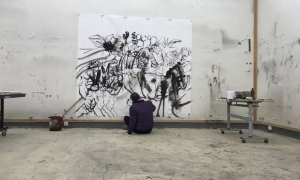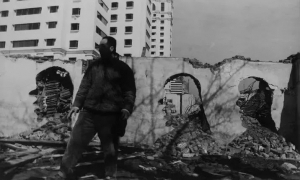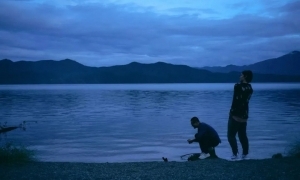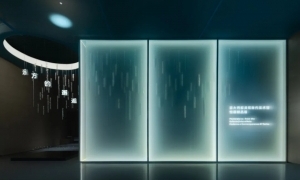Jeon Joonho,The Whote House ,2005年6月,数字动画,32分16秒,国家美术馆,台湾。
洛杉矶艺术馆(LACAM)和休斯顿美术馆(MFAH)将共同举办近二十年的首场针对韩国当代艺术的主题展览。这场名为“你的美好未来”的展览主要展出来自韩国的12位当代艺术家的作品,他们主要成长于80年代中期以后,既站在国际艺术潮流前沿,又保有明显的韩国背景。
“你的美好未来”的名字来自Bach Yiso的同名雕塑作品。展览将首先从6月28日至9月20日在洛杉矶艺术馆展出,12月22日至2010年2月14日在休斯顿美术馆进行第二阶段的展出。
“韩国是一个充满活力和复杂的艺术市场,但对于美国来说还是一片未知领域,”洛杉矶艺术馆首席执行官迈克尔戈万(Michael Govan)说,“洛杉矶艺术馆很高兴能将这一富有活力和见地的展览带到洛杉矶来,我们重新开放艺术馆的韩国画廊之后,这里将是韩国本土之外最大的韩国社区,我们将为游客带来传统和现代相融合的韩国当代艺术体验。”
休斯顿美术馆的主任皮特C表示说:“这次展览可以追溯到2004年我们在首尔的首次探访,经过四年来的不断探寻和无数的工作室访问后,策展人从一代韩国艺术家的独特创作中开辟了一个全新的视角。”
韩国当代艺术尽管在过去20年中一直保持着活力,但仍然是西方艺术市场未开发的领地。80年代以后,韩国艺术家越来越多的受到国际艺术潮流的影响,90年代以后他们开始在世界各地的展览上出现,并更多的开始在海外旅行、生活和工作。在与世界艺术交流学习的同时,韩国艺术家还十分重视个人经验和民族文化,他们的作品反映了他们的生活,他们处于一个政治动荡和自由开放的环境之中,韩国虽然是一个小国,但是正在日益繁荣强大起来。他们的作品通常以幽默的视角关注于自然生活的片段、时间、身份,以及语言、文化、时代对交流带来的阻碍和限制。
(来源:Artdaily,点击参看原文)
【编辑:张明湖】
LACMA Presents First Major U.S. Exhibition of Contemporary Korean Art in Nearly Two Decades
LOS ANGELES, CA.- The Los Angeles County Museum of Art presents the first major museum exhibition in the continental United States in almost two decades to focus on contemporary art from South Korea. Organized by LACMA and the Museum of Fine Arts, Houston (MFAH), Your Bright Future: 12 Contemporary Artists from Korea features a generation of artists who have emerged since the mid-1980s—some well-known and others on the brink of such recognition—all of whom work on the cutting-edge of international art trends and within a distinctly Korean context: Bahc Yiso, Choi Jeong-Hwa, Gimhongsok, Jeon Joonho, Kim Beom, Kimsooja, Koo Jeong-A, Minouk Lim, Jooyeon Park, Do Ho Suh, Haegue Yang and the collaborative, Young-Hae Chang Heavy Industries (family names are in bold). Your Bright Future (a deliberately ambiguous title taken from a sculpture by Bahc Yiso) will represent each artist through a large-scale installation or substantial body of work, including site-specific installations, video art, computer animation, and sculpture. The exhibition will premiere at LACMA, which has the most comprehensive collection of traditional Korean art outside of Korea and Japan, from June 28 through September 20, 2009. The show will then travel to the Museum of Fine Arts, Houston, November 22, 2009 through February 14, 2010.
“Korea has a vibrant and sophisticated contemporary art scene that is still relatively unknown in the United States,” said Michael Govan, LACMA CEO and Wallis Annenberg Director. “LACMA is thrilled to bring this insightful exhibition to Los Angeles—the largest Korean community outside of Korea—particularly as we reopen the museum’s Korean art galleries, providing our visitors both traditional and contemporary offerings of Korean art.”
Peter C. Marzio, director of the MFAH, commented, “The impetus for this landmark exhibition dates back to my revelatory first trip to Seoul in 2004. Four years and countless studio visits later, curators Christine Starkman and Lynn Zelevansky have opened an entirely new perspective on the extraordinary art being made by a generation of Korean artists. We are enormously pleased to have partnered with LACMA on this initiative.”
The contemporary art scene in Korea has remained relatively unexplored in the West despite its vibrancy during the last two decades. Throughout the 1980s, Korean artists became increasingly exposed to international art trends. With the proliferation of world-wide exhibitions and biennials in the 1990s, they increasingly began to travel, live, and exhibit abroad. While learning to communicate deftly in an international visual language, Korean artists also respond to their own personal experiences and their work reflects the culture out of which they emerged. The artists in Your Bright Future came of age amid political turmoil and increased freedoms in their small but increasingly prosperous country. Their experience has produced work that focuses, often humorously, on the ephemeral nature of life, time, and identity, as well as on the limitations of communication across languages, cultures, and generations. Each has made presence, absence, and change the center of their work.
Works by the only deceased artist, Bach Yiso, will be on view in the exhibition. Bahc's work Your Bright Future (2002/2009) is a sculpture in which ten bright lights augmented by reflectors and connected by a flimsy wooden structure face upward, shining on a large white wall. The lights are anthropomorphic, recalling a crowd basking in the glory of a charismatic leader. It could be a wholesome scenario or the group could be in thrall to an autocratic leader. Bahc’s billboard We Are Happy (2004) is presented here as a banner with these words printed in white Korean script against an orange background. In the simplest and most direct way, We Are Happy (2004) questions what happiness is, and who is experiencing it. For LACMA's exhibition, We Are Happy will hang at the museum's Wilshire Boulevard entrance.
Other outdoor works include three site-specific installations by the artist renowned as the father of Korean pop art, Choi Jeong-Hwa. In Welcome, swaths of brightly covered fabric are stretched from roof to balustrade on the south and west facades of LACMA's Ahmanson Building. Choi's other two works are both titled HappyHappy and made of commercial plastic containers. In the BP Grand Entrance, thousands of these colorful items, procured from local 99¢ stores, are strung together, reaching from the ceiling almost to the floor. Choi’s other work is an interactive, educational project. Visitors are invited to make their own sculptures out of plastic containers and hang them on five chain-link fences situated on LACMA’s campus.
Young-Hae Chang Heavy Industries is a Seoul-based collaborative that includes the Korean conceptual artist Young-Hae Chang and the American writer Marc Voge. Their works, made for the internet and as projections for gallery installations, combine words in different languages with their own sound compositions in Flash animations that pulse on the screen with great rapidity. For LACMA's presentation, Young-Hae Chang Heavy Industries has created a two-part work for the galleries titled SUCKERDOM; PLEASE COME PLAY WITH ME, BABY and SUCKERDOM: PLEASE DON'T THANK ME, and one work for the web also titled SUCKERDOM.
Jooyeon Park, the youngest artist in the exhibition, also creates works that address language, using written words, as well as performance, video, photography, found objects, and sculpture to stress the fragility of existence. She believes language is an inadequate communication system and often creates works by jumbling found texts.
Gimhongsok and Jeon Joonho address South Korea’s place in the world, as well as the complex relationship among the U.S., North Korea, and South Korea. Gimhongsok’s video projection G5 (2004), features five Koreans singing a heartfelt rendition of the national anthem of one of the G5 countries (U.S., United Kingdom, France, Japan, Germany) in Korean. Though an initial response may be amusement at the discordance of hearing familiar, patriotic tunes sung in a foreign language, the question arises whether the singers are somehow subservient to the powerful nations whose songs they sing. In a more sober work, Jeon Joonho focuses on the division of North and South Korea in Statue of Brothers (2008–09), an installation inspired by a story taken from a famous public memorial of two brothers fighting on different sides of the Korean War.
Other artists in the exhibition examine the sociological effects of Korea’s rapid modernization. In his work, Do Ho Suh compares the formal languages of Eastern and Western architecture with the understanding that differences in architecture reveal different social structures. In 1994, Suh began making “fabric architecture,” using filmy, translucent textiles like silk and nylon to create ghostly and fragile renderings of his childhood home that evoke homesickness and the sense of loss. These works, often large-scale installations, meld seeming opposites, like the notions of inside and outside, personal and public, past and present. In Fallen Star, 1/5 (2008), Suh shows a violent collision involving a traditional Korean house and the building housing the first apartment the artist rented in the U.S.
Kim Beom questions Korean mass media in Untitled (News) (2002), for which he edited together numerous television news broadcasts in clips short enough to alter what the reporters were saying. Instead of reporting on events of the day, these familiar figures spout statements that vacillate between the inane and poignant. Using humor, the work questions whether the actual words of such television personalities are more enlightening than the ones that Kim has put in their mouths. Minouk Lim’s three-channel DVD projection Wrong Question (2006) records an anonymous taxi driver who does not understand the progressive elements of South Korean society, and conflates pro-democracy and pro communist factions. On the adjacent screen is Lim’s young daughter, who dreams of her mother staying home instead of leaving to work. Her grandfather instructs her instead to say, “I’ll be a great painter like Mom.” “What’s a painter?” the child asks. The two seem to be participating in different conversations—the products of radically divergent life experiences.
Kimsooja reflects upon gender issues from a uniquely Korean perspective. Early in her career, the use of sewing and traditional Korean textiles—usually associated with women’s work—allowed her to explore the role of family and nature of identity. Today she melds masculine and feminine qualities in the meditative video works for which she is best known. They record her performances on the streets of cities all over the world. In them, she is still, seen from the back, while oceans of humanity move around her.
The works of Haegue Yang and Koo Jeong-A address what lies on the periphery of everyday experience, impermanent traces of human existence, and the hidden or ephemeral. Yang’s Storage Piece (2004), is composed of crated and wrapped works by the artist. Unsold, the pieces were returned to her after an exhibition; with a show coming up and no space to store her old pieces, she decided to exhibit them wrapped. The work is amusing, but also rooted in a genuine complaint regarding the accumulation of artwork, which artists frequently cannot afford to store. Too often it takes over their studios—a reminder of the failure to sell. In conjunction with the exhibition, Yang will present performances concerning Storage Piece during the exhibition’s opening events and as part of a public program during the course of the show. Like Yang, Koo Jeong-A is concerned with easily overlooked objects and situations, frequently photographing mundane environments; creating drawings that are so minimal in their physicality that they become elusive; and installing tiny sculptures high on a wall or low in a corner.
(来源:Artdaily,点击参看译文)





























